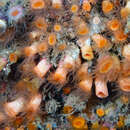Comprehensive Description
provided by Smithsonian Contributions to Zoology
Balanophyllia eguchii Wells, 1982
Balanophyllia eguchii Wells, 1982:211–213, pl. 1: figs. 4–6 [synonymy]; 1983:239, pl. 14: figs. 6–8.
DESCRIPTION.—Corallum colonial, small clusters of corallites formed by extratentacular budding from basal coenosteum and directly from corallite theca, augmented by settlement of sexually produced planulae on the colonial coenosteum. Second generation buds not uncommon but third generation buds rare. Corallites cylindrical; calices elliptical to greatly elongate (e.g., 13.5 × 6.5 mm for one on holotypic colony). Theca of corallites covered by thin epitheca for 50%–95% of height, generations of bryozoa keeping pace as the receding edge zone lays the epitheca. Costae equal in width and bear spiny granules. Intercostal striae deep and porous.
Septa basically hexamerally arranged, but total number of septa depends on size of calice: at a greater calicular diameter of 4.0 mm there are 36 septa; 5.5 –7.0 mm, 48 septa; 10.0 mm, 64 septa; and the largest calice 13.5 mm in greater calicular diameter has 80 septa. In 48-septa corallites, S1–2 are equal in size, only slightly exsert, and have straight, vertical inner edges, laciniate deep in fossa. S3 rudimentary and pairs of S4 meet before the S3 and extend to the columella but do not form paliform lobes. Inner edges of fused S4 also laciniate. Fossa deep and elongate. Columella rudimentary, composed of small crispate elements attached to the lowest inner edges of the larger septa.
MATERIAL EXAMINED.—JSL-13-XI-86-1, IRCZM; JSL-16-XI-86-2, USNM 84843, Plate 9i; JSL-19-XI-86-4, IRCZM; holotype of B. eguchii, USNM 46966, Plate 9h,j; off Rábida, USNM 78888 and 79097 (Wells, 1982); “Galápagos,” USNM 79096; Champion and Onslow Islands, Floreana, CAS 18927 and 18928 (Wells, 1982); Kaneohe Bay, USNM 79668 (Wells, 1982); off Japan, USNM 78646.
DISTRIBUTION.—Galápagos:off Santiago; Cousin’s Rock; Rábida; Santa Cruz; Champion and Onslow, Floreana; Española; 1–27 m. Elsewhere: off Japan; Hawaii; off Queensland, Australia; Gulf of Panama; Malpelo; 7–85 m (Wells, 1982).
Dendrophyllia de Blainville, 1830
33. Dendrophyllia gracilis Milne Edwards and Haime, 1848
Dendrophyllia gracilis Milne Edwards and Haime, 1848c:100, pl. 1: fig. 13; 1860:119.—Wells, 1983:240–241. pl. 17: figs. 1–4 [complete synonymy].
?Dendrophyllia sp.—Crossland, 1927:541.
DESCRIPTION OF GALAPAGAN SPECIMENS.—Corallum colonial: small bushy colonies formed primarily by extratentacular budding from edge zone and probably from basal coenosteum, and, to a lesser extent, by equal intratentacular budding (Plate 10a). Second generation extratentacular buds not uncommon but third generation buds not observed. Corallites cylindrical, up to 36 mm tall and 13 mm in greater calicular diameter. Calices circular to irregularly elliptical in shape. Costae thin (about 0.14 mm) and “vermiculate,” bearing small triangular teeth. Intercostal striae of equal width to costae and relatively deep. Theca porous and relatively thin, never epithecate.
Septa irregular in symmetry. Small corallites hexameral: S1>S2>S4>S3; however, with increase in calicular diameter (e.g., 8–11 mm), pairs of S5 are gradually added and concurrently the S2 increase to a size equal to the S1. Ultimately, a full five cycles are present at a calicular diameter of 13–14 mm, the higher cycle septa arranged in the Pourtalès Plan. Corallites with 8, 9, 10, and 11 primary septa (with a corresponding number of 64,72,80, and 88 septa) are therefore not unusual. Septa nonexsert or only slightly so, the higher cycle septa having laciniate inner edges. Inner edges of S5 do not bear paliform lobes. Fossa extremely deep, containing an irregularly shaped spongy columella of variable size, ranging from quite small to massive.
MATERIAL EXAMINED.—JSL-20-XI-86-2, IRCZM; JSL-21-XI-86-5, IRCZM; off Cousin’s Rock and Sullivan’s Bay, Santiago, USNM 46971 (Plate 10a,b), 79103 (Wells, 1983); off Rábida, CAS 18925 (Wells, 1983); 7–12 m; off Palau, USNM 47223–7230, 46972, 78644; off Australia, USNM 78537; off Singapore, USNM 78531–2; Malaysia, USNM 78533, 78535.
DISTRIBUTION.—Galápagos: off Isabela (Crossland, 1927); Santiago; Rábida; Española; (Wells, 1983); 0–12 m. Elsewhere: common throughout Indo-West Pacific, and off eastern Australia; 0–45 m (Wells, 1983).
- bibliographic citation
- Cairns, Stephen D. 1991. "A revision of the Ahermatypic Scleractinia of the Galapagos and Cocos Islands." Smithsonian Contributions to Zoology. 1-32. https://doi.org/10.5479/si.00810282.504
Comprehensive Description
provided by Smithsonian Contributions to Zoology
Cladopsammia eguchii (Wells, 1982), comb. nov
Dendrophyllia arbuscula var. compressa Eguchi and Suzuki, 1973:84, pl. 1: fig. 3.
Balanophyllia eguchii Wells, 1982:211, 213, pl. 1: figs. 4–6; 1983:239–240.—Cairns, 1991a:23, pl. 9: figs. h–j.
DESCRIPTION.—Illustrated colony a small (2.5 cm in width) phaceloid corallum composed of only 5 corallites, 3 of them rooted in a common basal coenosteum, the other 2 budded from 2 of the larger corallites. Calices of small corallites circular, but calices of larger corallites (up to 13 × 9 mm in diameter) tend to be elongate. Synaticulotheca thick and porous, covered by costae 0.35 mm wide, each bearing a unilinear row of dentate granules. Corallum white; polyps red (Eguchi and Suzuki, 1973).
Septa hexamerally arranged in a weak Pourtalès Plan, the largest corallites having a full fifth cycle (96 septa), but most corallites lacking many pairs of S5. S1–3 equal in size, little exsert, and have straight, vertical, entire inner edges that border the columella. All S4 quite narrow. Pairs of S5 unite before their mutually adjacent S4 and either extend as a single septum to the columella or are fused with their counterpart within the half-system before the S5 and continue on to the columella. Thus, inner edges of 24–48 septa may border the columella of a large corallite. Fossa of moderate depth, containing an elongate, spongy columella.
- bibliographic citation
- Cairns, Stephen D. 1994. "Scleractinia of the temperate North Pacific." Smithsonian Contributions to Zoology. i-150. https://doi.org/10.5479/si.00810282.557.i
Biology
provided by World Register of Marine Species
azooxanthellate
van der Land, J. (ed). (2008). UNESCO-IOC Register of Marine Organisms (URMO).
- license
- cc-by-4.0
- copyright
- WoRMS Editorial Board
Habitat
provided by World Register of Marine Species
shelf
van der Land, J. (ed). (2008). UNESCO-IOC Register of Marine Organisms (URMO).
- license
- cc-by-4.0
- copyright
- WoRMS Editorial Board

